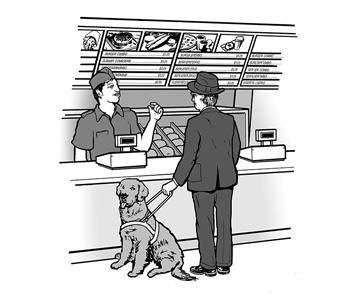






Communication is key
“Does this come in blue?” “I like my shirts with light starch, on hangers.” “What are your specials today?” “What aisle is shampoo in?”
Communicating successfully with customers is an essential part of doing business, and many businesses work hard to have good communication with their customers. But, when dealing with customers who are blind or have low vision, customers who are deaf or hard of hearing, or customers who have disabilities that impair speech, many business owners and employees are uncomfortable or are not sure what to do. This lesson provides the answers.
Communicating effectively
Under the ADA, businesses are expected to communicate effectively with customers who have vision, hearing, or speech disabilities, and are responsible for taking the steps that are needed for effective communication. Business owners or managers must decide what assistance is appropriate, depending on the nature of the communication and the customer’s normal method of communication.
The rules are intentionally flexible. Different businesses - a lawyer’s office, a restaurant, a theater, and a grocery store, for example - may need different solutions, because the nature of their communications are different. Also, different customers need different solutions, because the nature of their disabilities are different.
|
|
|
Practical solutions
The aim is to figure out practical solutions that allow you to communicate with customers who have disabilities, fit with your type of business, and comply with the ADA. Some easy solutions work in relatively simple and straightforward situations. Other, more extensive solutions are needed where the information being communicated is more extensive or complex.
Usually the customer will tell you what technique he or she needs or will ask which ones you provide. Or, you can ask what technique he or she normally uses to understand printed information (if he or she has a vision disability) or spoken information (if he or she has a hearing disability). This information is helpful in deciding how to provide effective communication.
|
|
|
|
|
|






